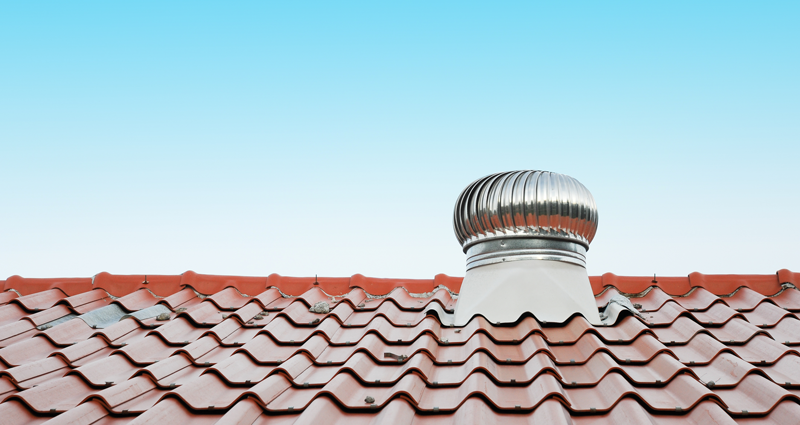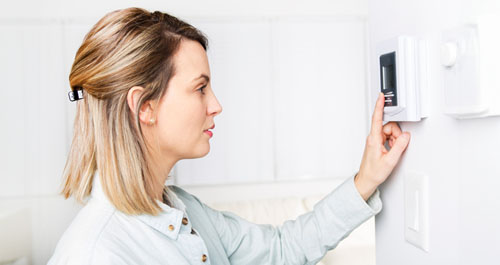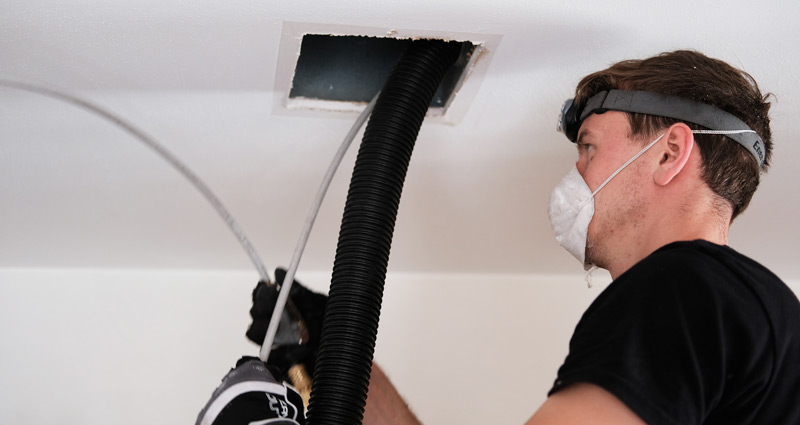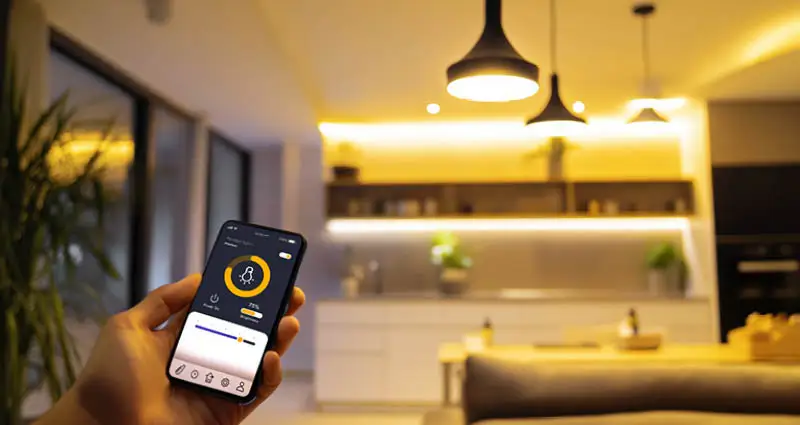Forced air systems
Electric-resistance forced air heating is 100% energy efficient because all the electricity is converted to heat. And since the heating elements in an electric furnace are in direct contact with the air, the air heats up very quickly. This makes them very efficient but expensive to operate during extended cold weather.
Other types of forced air systems
- In natural gas/propane systems, you want the heat from a series of flames to heat the air, but you also want to send the combustion exhaust out of the house. A heat exchanger is a tall, hollow hair comb on a gas system that surrounds each of the system’s ribbon burners. The hot gases move up into the heat exchanger and eventually exhaust into the vent pipe. Highly efficient condensing gas furnaces use a fan to blow the exhaust outside.
- Heat pumps include outside air condensers and underground geothermal condensers. Both use R-410A refrigerant, but the process runs in reverse so that instead of warm air being expelled outside as waste heat, it's blown inside to supply heat. Heat pumps use compressor/condensing systems similar to regular air conditioning systems, except they are reversible.
- Geothermal systems perform similarly, but use the subsurface ground temperature, which stays around 50°F, making them very reliable and energy efficient.
- Ductless heat pump/AC systems are forced air systems that don't use ductwork. Sometimes called "split systems," the interior air handling and heat exchanging unit is directly connected through the exterior wall to the outside unit. Because of their small size and the fact that they don't use ductwork, split systems like these are best suited for heating and cooling small areas.
Forced air system cost
Installation costs of these systems vary significantly depending on the circumstances. Electric resistance, natural gas and propane systems are often the most affordable options in new construction and homes with existing duct networks. But if you need to install a duct system in an existing home, the ductwork cost may be several times the heater's price.
- Air heat pump installation and equipment costs can be twice as high or higher than those of installing electric, gas or propane furnaces.
- Geothermal heat pumps are typically the most expensive to install, with installation costs dependent on the complexity of the installation of underground piping.
- Ductless systems may be the cheapest option if you're only heating one room, but because you need a separate system for each heated space, the installation and equipment cost increases with the number of systems.
As for operating costs, geothermal heat pumps are the most affordable, followed by air heat pumps and ductless systems. Natural gas is typically the cheapest among electric resistance, natural gas and propane systems. Still, the operating costs are tied to the fluctuating prices of their energy sources: electricity, natural gas and propane.
Forced air system maintenance
Airflow is the lifeblood of any forced air system, and the "chokepoint" for that airflow is the filter. Every forced air system has a filter that must be replaced or cleaned on a certain schedule, and neglecting to perform this maintenance on time can result in higher operating costs and increased system wear.
Any system with an outdoor condenser installed at ground level (this excludes geothermal heat pumps and ductless systems) requires some additional DIY maintenance. The condenser should be kept free of weeds and debris and gently hosed off occasionally to clear away dirt.
All other maintenance should be performed by a licensed HVAC professional, ideally before the start of the heating season. This maintenance should be performed anually, no matter how well the system functions. Annual maintenance extends the system's life, optimizes energy efficiency and ensures the system's safety.
Radiant systems
In the case of all heat radiating systems, they work silently and emit blasts of warm air. However, they tend to warm spaces more slowly when compared to forced air systems. This is largely because they rely on convection to heat the air and make it circulate through the room. That said, some types of radiant systems work faster than others.
Radiant heat can be more efficient than forced air systems with duct loss problems. Plus, some people with allergies prefer radiant heat because the lack of air circulation doesn't stir up allergens. However, because these systems circulate water as either steam or liquid, radiator systems can be prone to problems such as blockages and leaks.
Types of radiant systems
- Passive solar is the greenest and potentially least expensive to operate because the sun's heat is stored in the home's thermal mass. The sun's heat radiates and warms the space. However, your home needs to be very well air sealed and insulated, plus have adequate southern exposure to allow enough sunshine to enter the windows and warm the house.
- Boiler-based systems include radiant floor heat using hot water, old-fashioned radiators using steam or hot water, and some hydronic (liquid-based) baseboard systems. In these systems, a central boiler heats the water (or other liquid) to either steam or hot water and pumps it through pipes throughout the home to radiators or coils of tubing embedded in walls or flooring.
- Radiant floor heat makes use of the floor's thermal mass. When you take hot water tubing and arrange it in loops on the floor and then surround it with poured concrete (wet installation) or a sandwich of tile and plywood (dry installation), the floor will stay warm longer and radiate the heat longer, which keeps the room warm longer and more evenly. The bigger the floor space, the more it can be heated and the more heat it will store.
Baseboard heat
Electric and hydrionic baseboard systems work best when mounted at least 3/4" above the floor or carpet. This allows cooler air on the floor to flow through the heater fins and be heated. One drawback is that pet hair and other particles can get pulled into these heaters and block airflow.
- Electric baseboard heaters (that use electric resistance heating elements) are mostly zonal heaters, so a built-in thermostat controls each. Electric baseboard heaters tend to be the least expensive, easiest-to-install heating system. They only need to be wired up and fastened to the wall.
- Hydronic baseboard systems use water or oil instead of electric resistance. In electric resistance systems, once the current shuts off, the heating element goes cold in just a few minutes. But in hydronic systems, once the liquid is hot, it stays hot longer, making them a little more efficient to operate than electric resistance baseboards. Hydronic systems can be installed as individual units or as a single whole-house system that uses a single heater, much like a radiant or radiator system.
Radiant system cost
The installation costs of radiant systems tend to be even more difficult to estimate than those of forced air systems. With passive solar heating, for example, the heating elements are integral to the home's construction. They could add anywhere from a few thousand to tens of thousands of dollars to the cost of designing and building new construction.
- With boiler-based systems, boiler installation costs a few thousand dollars (comparable to electric, gas or propane furnaces) for smaller boilers into 5-figure sums for larger ones. If radiators, hydronic baseboards or floor heat piping must be installed, the cost is tied directly to the number of units or square feet of flooring. So, the cost of both the boiler and the heat distribution equipment increases with the size of the home.
- Similarly, the cost of electric radiant floor heat installation usually boils down to a price per square foot, so the total cost depends on the size of the home. In the typical home, the operating costs of these radiant systems tend to be lower than those of electric, gas and propane furnaces but higher than those of heat pumps.
As with installation, however, this can vary along with the size of the home. Electric radiant floor heating is expensive to operate, for example. In a tiny house, this may be cheaper than installing a furnace and ductwork or a series of mini-split systems. But in a huge home, heating entirely with electric radiant flooring could be a costly mistake.
Radiant system maintenance
Compared to forced air systems, radiant systems are typically easier and usually cheaper to maintain. An annual boiler inspection and tune-up is often the only routine maintenance cost associated with boiler-based systems.
Passive solar homes are maintenance-free on the inside. Still, they can require ordinary outdoor maintenance like clearing gutters, trimming trees and washing windows to ensure sufficient exposure to the sun's warming rays. Electric radiant flooring is generally maintenance-free, unless the system isn't performing as expected. Electric baseboard heaters require routine vent cleaning, especially if your home is dusty or you have pets.
Choosing the best home heating system for your needs
The type of heating system you choose depends on several factors: how your home is built, what you can afford and your preferences. For example, if you are making an addition or modernizing your home's HVAC, you may find that running new ductwork to different parts of your home might not be feasible. Consider baseboard systems coupled with a ductless mini system for summertime cooling in this case. While forced air systems may stir up allergens, when equipped with HEPA air filtration, they do a much more efficient job of purging allergens from the air throughout the home.
If it's a matter of energy efficiency but passive solar is not a practical choice, the most efficient is a geothermal heat pump, followed by the air heat pump. While these are very effective heating systems, during events like cold snaps, they require heating backups — usually in the form of built-in auxiliary electric resistance heating elements.
If you're updating your home's heating system or need maintenance, contact a skilled professional for expert service.
Keep your home and wallet comfortable with an energy plan from Direct Energy. We have the tools and tips you need to track your appliances' usage to save energy and money.




































